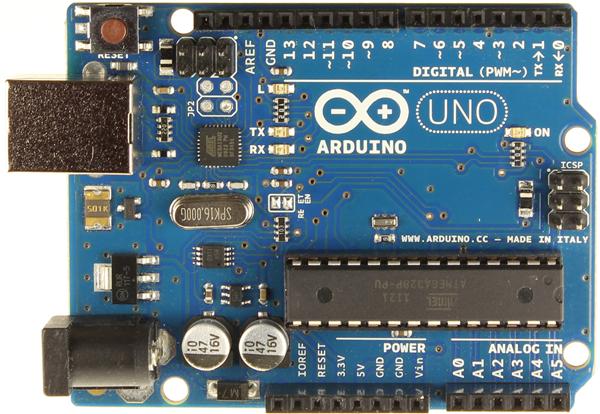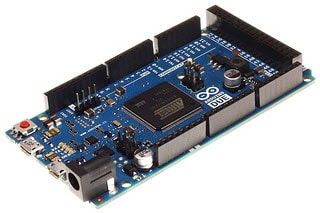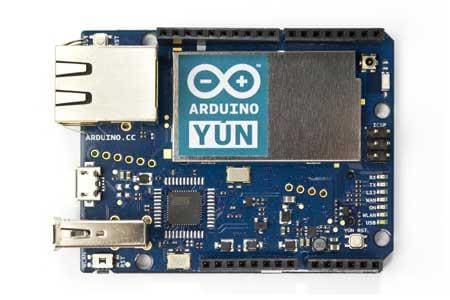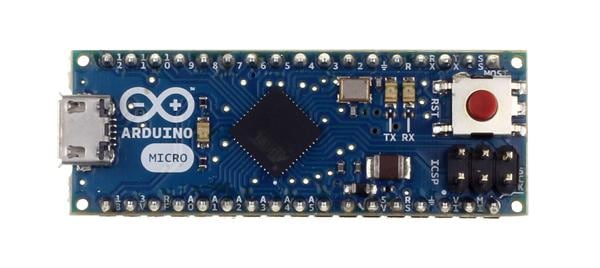Arduino Development Boards
Arduino provides open-source electronics prototyping platforms based on flexible, easy-to-use hardware and software. Arduino prototyping platforms are intended for artists, designers, hobbyists, and anyone interested in creating interactive objects or environments. Arduino's prototyping platforms can sense the environment by receiving input from a variety of sensors and can affect their surroundings by controlling lights, motors, and other actuators. Arduino projects can be stand-alone or they can communicate with software running on a computer.
Arduino Uno Microcontroller Board

Arduino Uno is a microcontroller development board based on the Atmel ATmega328 MCU. The Arduino Uno has 14 digital input/output pins (of which 6 can be used as PWM outputs), 6 analog inputs, a 16 MHz crystal oscillator, a USB connection, a power jack, an ICSP header, and a reset button. This Arduino MCU board contains everything needed to support the microcontroller. Simply connect it to a computer with a USB cable or power it with a AC-to-DC adapter or battery to get started. The Arduino Uno differs from all preceding boards in that it does not use the FTDI USB-to-serial driver chip. Instead, it features the Atmega8U2 programmed as a USB-to-serial converter. The Arduino Uno MCU board can be powered via the USB connection or with an external power supply. The power source is selected automatically.
Arduino Due Microcontroller Board

Arduino Due Microcontroller Board is based on the 32-bit processor Atmel SAM3X8E ARM Cortex-M3 MCU, and improves all the standard Arduino functionalities and adds many new features. The Arduino Due offers 54 digital input/output pins (of which 12 can be used as PWM outputs, with selectable resolution), 12 analog inputs with 12 bits of resolution, 4 UARTs, two DAC outputs, an 84MHz crystal oscillator, two USB connections, 2 TWI, a power jack, an ICSP header, an SPI header, a JTAG header, and a reset button and erase button. The maximum voltage that the I/O pins can provide or tolerate is 3.3V. The board has two micro USB connectors--one for debugging purposes and a second one capable of acting as a USB host, allowing external USB peripherals such as mouse, keyboards, smartphones, etc. to be connected to the Arduino Due.
Intel Galileo Development Board

Intel's Galileo Development Board is based on the Intel Quark SoC X1000 Application Processor, a 32-bit Intel Pentium-class system on a chip (SoC). It is the first board based on Intel architecture designed to be hardware and software pin-compatible with shields designed for the Arduino Uno R3. The Galileo board is also software-compatible with the Arduino Software Development Environment, which makes usability and introduction a snap. In addition to Arduino hardware and software compatibility, the Galileo board has several PC industry standard I/O ports and features to expand native usage and capabilities beyond the Arduino shield ecosystem. A full sized mini-PCI Express slot, 100Mb Ethernet port, Micro-SD slot, RS-232 serial port, USB Host port, USB Client Port, and 8 MByte NOR flash come standard on the board.
Arduino Yún Microcontroller Board

Arduino Yún Microcontroller Board is the first stand-alone Arduino featuring built-in Ethernet and WiFi support, removing the need for a board as well as a WiFi shield. It is based on the Atmel ATmega32u4 and the Atheros AR9331. The Atheros processor supports a Linux distribution based on OpenWRT named Linino. The board has built-in Ethernet and WiFi support, a USB-A port, micro-SD card slot, 20 digital input/output pins (of which 7 can be used as PWM outputs and 12 as analog inputs), a 16MHz crystal oscillator, a micro USB connection, an ICSP header, and a 3 reset buttons. The Yún distinguishes itself from other Arduino boards in that it can communicate with the Linux distribution onboard, offering a powerful networked computer with the ease of Arduino. In addition to Linux commands like cURL, users can write their own shell and python scripts for robust interactions. The Yún has built-in USB communication, eliminating the need for a secondary processor. This allows the Yún to appear to a connected computer as a mouse and keyboard, in addition to a virtual (CDC) serial / COM port.
Arduino Leonardo Development Board

Arduino Leonardo AVR Development Board is a microcontroller board based on the Atmel ATmega32u4. It offers 20 digital IOs (of which 7 can be used as PWM outputs and 12 as analog inputs), a 16MHz crystal oscillator, a micro USB connection, a power jack, an ICSP header, and a reset button. The Leonardo differs from all preceding boards in that the ATmega32u4 has built-in USB communication, eliminating the need for a secondary processor. This allows the Leonardo to appear to a connected computer as an HID, such as a mouse or keyboard, in addition to a virtual (CDC) serial / COM port. The Leonardo board contains everything needed to support the microcontroller. Simply connect it to a computer with a USB cable or power it with an AC-to-DC adapter or battery to get started.
Arduino Micro Development Board

Arduino Micro AVR Development Board is a microcontroller board based on the Atmel ATmega32u4. It has 20 digital input/output pins (of which 7 can be used as PWM outputs and 12 as analog inputs), a 16 MHz crystal oscillator, a micro USB connection, an ICSP header, and a reset button. It contains everything needed to support the microcontroller; simply connect it to a computer with a micro USB cable to get started. It has a form factor that enables it to be easily placed on a breadboard. The Micro is similar to the Arduino Leonardo in that the ATmega32u4 has built-in USB communication, eliminating the need for a secondary processor. This allows the Micro to appear to a connected computer as a mouse and keyboard, in addition to a virtual (CDC) serial / COM port.
Arduino Mini Development Board

Arduino AVR Mini and Mini Lite Microcontroller Boards are small boards based on the ATmega328 microcontroller, which are intended for use on breadboards and when space is limited. Arduino AVR Mini and Mini Lite Microcontroller Boards each have 14 digital input/output pins (of which 6 can be used as PWM outputs), 8 analog inputs, and a 16 MHz crystal oscillator. They can be programmed with the Mini USB adapter or other USB or RS232 to TTL serial adapters.
Arduino Mega Development Board

Arduino Mega2560 microcontroller board is an easy-to-use development board based on the Atmel ATmega2560 MCU. The ATmega2560 has 256 KB of flash memory for storing code (of which 8 KB is used for the bootloader), 8 KB of SRAM, and 4 KB of EEPROM. The Arduino Mega2560 microcontroller board has 54 digital input/output pins (of which 14 can be used as PWM outputs), 16 analog inputs, 4 UARTs (hardware serial ports), a 16 MHz crystal oscillator, a USB connection, a power jack, an ICSP header, and a reset button. The Arduino Mega2560 contains everything needed to support the MCU. Simply connect it to a computer with a USB cable or power it with a AC-to-DC adapter or battery to get started. This Arduino development board is compatible with most shields designed for the Arduino Duemilanove or Diecimila. The Arduino Mega2560 differs from all preceding boards in that it does not use the FTDI USB-to-serial driver chip. Instead, it features the Atmega8U2 programmed as a USB-to-serial converter. The Arduino MCU board includes a number of facilities for communicating with a computer, another Arduino, or other MCUs.
Arduino Mega Android Development Board

Arduino Mega Android™ Development Kit is a microcontroller board based on the ATmega2560. It has a USB host interface to connect with Android-based phones, based on the MAX3421e IC. It has 54 digital input/output pins (of which 14 can be used as PWM outputs), 16 analog inputs, 4 UARTs (hardware serial ports), a 16 MHz crystal oscillator, a USB connection, a power jack, an ICSP header, and a reset button. Similar to the Mega 2560 and Uno, the Arduino Mega Android Development Kit features an Atmega8U2 programmed as a USB-to-serial converter.
Arduino Nano Development Board

Arduino Nano 3.0 is a small, complete, and breadboard-friendly surface mount embedded version of Arduino with integrated USB, which is based on the ATmega328. It has everything that the Arduino Diecimila/Duemilanove has, electrically, with more analog input pins and an onboard +5V AREF jumper. The Nano 3.0 works with a Mini-B USB cable, and can be powered via the Mini-B USB connection, a 6-20V unregulated external power supply (pin 30), or a 5V regulated external power supply (pin 27). The power source is automatically selected to the highest voltage source. The Nano has the breadboard-ability of the Boarduino and the Mini+USB, with a smaller footprint than either, so users have more breadboard space. It also has a pin layout that works well with the Mini or the Basic Stamp (TX, RX, ATN, GND on one side, power, and ground on the other). This 3.0 version comes with the ATMEGA328, which offers even more programming and data memory space.
Arduino Esplora Development Board

Arduino's Esplora Development Board is a microcontroller board derived from the Arduino Leonardo. The Esplora differs from all preceding Arduino boards in that it provides a number of built-in, ready-to-use set of on board sensors for interaction. It's designed for people who want to get up and running with Arduino without having to learn about the electronics first. The Esplora has on-board sound and light outputs, and several input sensors, including a joystick, a slider, a temperature sensor, an accelerometer, a microphone, and a light sensor. It also has the potential to expand its capabilities with two Tinkerkit input and output connectors, and a socket for a color TFT LCD screen. The Esplora uses an Atmega32U4 AVR microcontroller with 16 MHz crystal oscillator and a micro USB connection capable of acting as a USB client device, like a mouse or a keyboard.